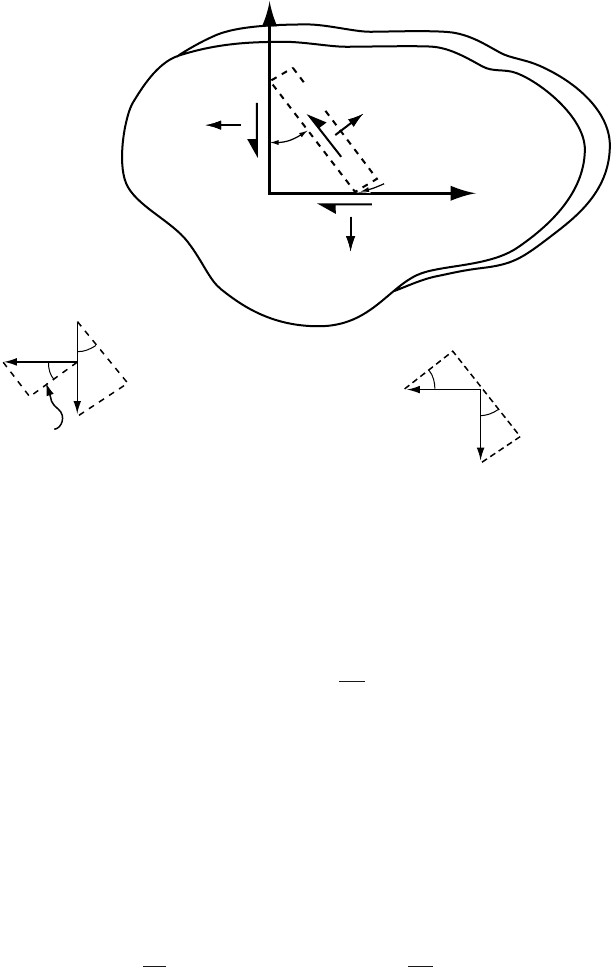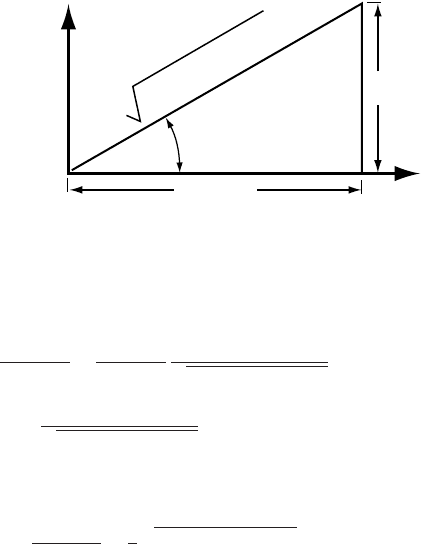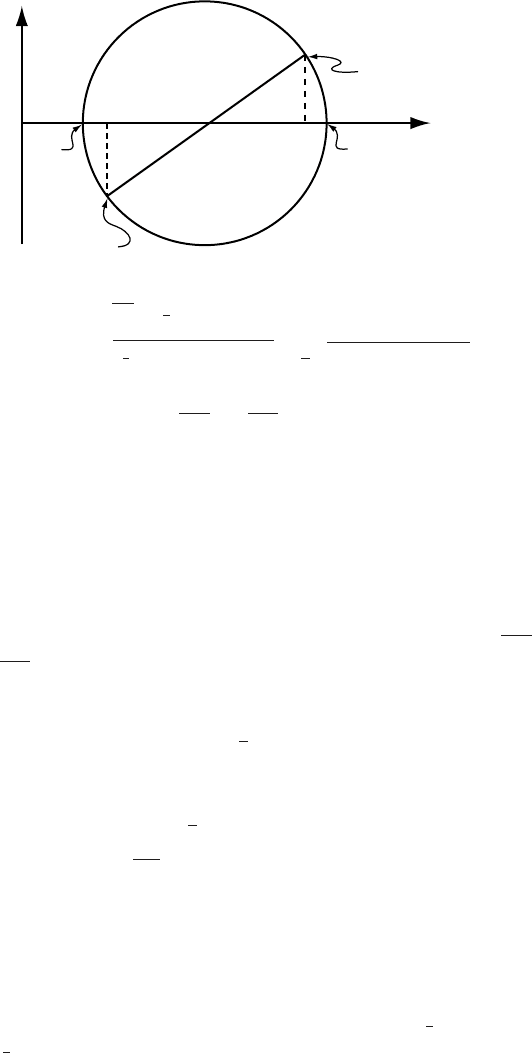Hooke R.L. Principles of glacier mechanics
Подождите немного. Документ загружается.

Summary 251
In the last part of the chapter, we investigated three problems of
geomorphic interest: the formation and courses of eskers, the origin
of tunnel valleys, and the erosion of cirques and overdeepenings. Many
esker characteristics can be understood in terms of gradients of hydraulic
potential at the base of an ice sheet. The source of the water that carved
tunnel valleys is unclear, but indications are that large discharges were
involved at least occasionally. Erosion of hard bedrock by glaciers is
greatly facilitated by fluctuations in water pressure at the bed.
Chapter 9
Stress and deformation
In this chapter we will derive general equations for calculating the force
per unit area, or traction, on a plane that is not parallel to the coordinate
axes, and then use these equations to determine the orientation of the
plane on which tractions are a maximum. We will see how this leads
to the concept of the invariant of a tensor, and show that this provides
the fundamental basis for Glen’s flow law. Then we derive the stress
equilibrium equations.
In the second half of the chapter we derive expressions for strain rates
in terms of velocity derivatives, and develop some relations based on
these expressions and some other basic equations. This will set the stage
for calculating stresses and velocities in a very simple ice sheet, consist-
ing of a slab of ice of uniform thickness on a uniform slope (Chapter 10)
and for investigating some more realistic problems (Chapter 12).
Stress
Although we have been referring to stresses and strain rates throughout
the last few chapters, we will now enter into a much more detailed
discussion, involving the tensor properties of these quantities. The reader
may find it helpful, therefore, to review the section on stresses and strain
rates in Chapter 2.
General equations for transformation of stress
in two dimensions
Consider a domain in a slab of material of unit thickness (measured
normal to the page) as shown in Figure 9.1. Stresses are uniformly
252

Stress 253
y
s
S
(q)
s
yx
s
xy
q
B
s
xx
s
yy
C
A
x
s
xy
sin q
s
yy
sin q
s
yy
cos q
s
xy
cos
q
s
yy
s
xy
s
xy
sin q
s
xy
cos q
s
xx
cos q
s
xx
sin q
s
xx
s
xy
s
N
(q)
Figure 9.1. Stresses on a triangular prism of material isolated from a domain.
distributed over the domain; in terms of the x–y coordinate system
shown, they are σ
xx
and σ
yx
in the x-direction, and σ
yy
and σ
xy
in the
y-direction. Shear forces on any small element of the domain of unit
size in the x- and y-directions must be in equilibrium if there is to be no
tendency for the element to rotate. Thus, σ
xy
= σ
yx
,sowewill use σ
xy
to represent both. Now cut the domain along plane AC,which makes an
angle θ with the y-axis. This plane has an area which we designate dA.
As a consequence of the stress field in the slab, the edges of the cut will
have a tendency to move with respect to one another. We will ignore the
part of the domain to the right of the cut, and ask what forces must be
applied on dA to balance this tendency. Specifically, we wish to find the
stress vectors σ
N
(θ) and σ
S
(θ)onthis plane, where the subscripts N and
S refer to normal and shear respectively.
To do this, consider the prism ABC, and sum forces on it that act
normal (F
N
) and parallel (F
S
)todA, remembering that a force is a stress
times an area, and set the sums equal to 0, the condition for static equi-
librium. Note that surface
AB has area dA cos θ and surface BC has area
dA sin θ. The force summation yields:
F
N
= σ
N
(θ)dA − σ
xx
cos
2
θdA − σ
xy
sin θ cos θ dA
−σ
xy
cos θ sin θ dA − σ
yy
sin
2
θdA = 0

254 Stress and deformation
and
F
S
= σ
S
(θ)dA + σ
xx
sin θ cos θ dA − σ
xy
cos
2
θdA
+σ
xy
sin
2
θdA − σ
yy
cos θ sin θ dA = 0
Simplifying results in:
σ
N
= σ
xx
cos
2
θ + σ
yy
sin
2
θ + σ
xy
(2 sin cos θ )
and
σ
S
=−
1
2
(σ
xx
− σ
yy
)(2 sin θ cos θ) + σ
xy
(cos
2
θ − sin
2
θ)
These relations may be further simplified with the use of the trigono-
metric identities:
sin 2θ = 2 sin θ cos θ
and
cos 2θ = cos
2
θ − sin
2
θ = 2 cos
2
θ − 1 = 1 − 2 sin
2
θ
to yield:
σ
N
= σ
xx
(1 +cos 2θ)
2
+ σ
yy
(1 −cos 2θ)
2
+ σ
xy
sin 2θ
or
σ
N
=
σ
xx
+ σ
yy
2
+
σ
xx
− σ
yy
2
cos 2θ + σ
xy
sin 2θ (9.1)
and
σ
S
=−
σ
xx
− σ
yy
2
sin 2θ + σ
xy
cos 2θ (9.2)
These are the desired relations for σ
N
(θ) and σ
S
(θ).
Principal stresses
We now wish to find the orientation, θ,ofthe plane on which σ
N
is
either a maximum or minimum. Take the derivative of Equation (9.1)
with respect to θ and set the result equal to 0, thus:
∂σ
N
∂θ
=−2
σ
xx
− σ
yy
2
sin 2θ + 2σ
xy
cos 2θ = 0 (9.3a)
or
tan 2θ =
2σ
xy
(σ
xx
− σ
yy
)
(9.3b)
This equation may be satisfied by either of two values of 2θ , 180
◦
apart.
Thus, there are two solutions for θ that are 90
◦
apart. One is the plane
of maximum σ
N
and the other is the plane of minimum σ
N
.Wecall
the stresses acting in these directions the principal stresses. This is an
important concept to understand, and we will return to it frequently.

Stress 255
2q
2s
xy
(s
xx
−
s
yy
)
2
+4s
xy
2
s
xx
−s
yy
Figure 9.2. Illustration of
relation among (σ
xx
– σ
yy
), σ
xy
,
and 2θ in Equation (9.3b).
The magnitude of the principal stresses is obtained by substituting
for 2θ in Equation (9.1). Equation (9.3b) and the diagram in Figure 9.2
are used to get expressions for cos 2θ and sin 2θ. The result is:
σ
1,2
=
σ
xx
+ σ
yy
2
+
σ
xx
− σ
yy
2
σ
xx
− σ
yy
(σ
xx
− σ
yy
)
2
+ 4σ
2
xy
+σ
xy
2σ
xy
(σ
xx
− σ
yy
)
2
+ 4σ
2
xy
or
σ
1,2
=
σ
xx
+ σ
yy
2
±
1
2
(σ
xx
− σ
yy
)
2
+ 4σ
2
xy
(9.4)
σ
1
is σ
Nmax
and σ
2
is σ
Nmin
. Thus, (σ
1
+ σ
2
) = (σ
xx
+ σ
yy
).
Comparing Equations (9.2) and (9.3a), it will be seen that
(∂σ
N
/∂θ ) = 2σ
S
. Thus when (∂σ
N
/∂θ ) = 0, 2σ
S
= 0. This is another
important principle. Shear stresses vanish on planes on which the
normal stresses are a maximum or minimum.
The orientations and magnitudes of the maximum shear stresses
can be obtained in a similar manner. This is left as an exercise for the
reader.
Mohr’s circle
A convenient way to illustrate the dependence of σ
xx
, σ
yy
, and σ
xy
on 2θ
is to use a graphical construction known as Mohr’s circle (Figure 9.3).
To construct the figure do the following.
(1) Draw a rectangular coordinate system with normal stresses (σ
N
)on
the abcissa and shear stresses (σ
S
)onthe ordinate, and plot points A
and A
at (σ
xx
, σ
xy
) and (σ
yy
, −σ
xy
), respectively.
(2) Connect points A and A
with a straight line, and draw a circle with
B as the center and passing through A and A
.

256 Stress and deformation
s
1
O
CB
A
ED
s
xx
(s
xx
,s
xy
)
s
N
(s
xx
, −s
xy
)
A'
s
yy
s
2
s
S
Figure 9.3. Mohr’s circle.
In this figure, BE =
1
2
(σ
xx
− σ
yy
)sothe radius of the circle is:
1
2
(σ
xx
− σ
yy
)
2
+ σ
2
xy
=
1
2
(σ
xx
− σ
yy
)
2
+ 4σ
2
xy
Thus, from Equation (9.4) the magnitudes of σ
1
and σ
2
are represented
by the lengths of lines
OD and OC respectively, and angle ABD is 2θ.
Invariants of a tensor
Regardless of the orientation of the axes in Figure 9.1, the magnitudes
and orientations of σ
1
and σ
2
cannot change as long as the overall stress
field does not change. This is because σ
1
and σ
2
are functions of the state
of stress in the domain and not of θ .Wenow use this fact and Mohr’s
circle to illustrate another fundamental principle.
Because the magnitudes of σ
1
and σ
2
,asrepresented by OD and
OC respectively, determine the size of the circle and its position on the
σ
N
-axis, the size and position do not change as θ varies. Thus:
1
2
(σ
xx
+ σ
yy
) (9.5a)
and
1
2
(σ
xx
− σ
yy
)
2
+ 4σ
2
xy
1/2
(9.5b)
(represented by OB and the radius of the circle, respectively) remain
constant. These two quantities are thus independent of the orientation of
the axes, or θ; they are known as the invariants of the tensor. On the other
hand, σ
xx
, σ
yy
, and σ
xy
do vary as θ varies. This variation is represented
by movement of points A and A
around the circle.
Phrased in terms of Equation (9.4), σ
1
and σ
2
will remain con-
stant and independent of θ only if the quantities
1
2
(σ
xx
+ σ
yy
) and
1
2
[(σ
xx
− σ
yy
)
2
+ 4σ
2
xy
]
1/2
are independent of θ . Thus, these two quan-
tities must be invariant.

Stress 257
Extension to three dimensions and introduction of
deviatoric stresses
It has been found empirically that, to a first approximation, deformation
of ice subjected to a normal stress is independent of the hydrostatic pres-
sure or mean stress, P (see discussion of Equation (4.9)). This might well
be anticipated from the observation that ice is (nearly) incompressible.
In three dimensions, the mean stress is given by:
P =
1
3
(σ
xx
+ σ
yy
+ σ
zz
) (9.6)
Because deformation is independent of P,wedefine a new set of stresses,
denoted by primes, by σ
xx
= σ
xx
− P, σ
yy
= σ
yy
− P, and σ
zz
= σ
zz
− P.
These stresses are variously known as deviatoric stresses, stress devia-
tors,ornon-hydrostatic stresses. “Deviator” refers to the fact that they
are deviations from the mean stress.
A more compact relation for the deviatoric stresses is:
σ
ij
= σ
ij
−
1
3
ij
σ
kk
i, j, k = x, y, z (9.7)
Here, we have introduced the Kronecker ;
ij
takes the values:
ij
= 1 i = j
ij
= 0 i = j
We have also introduced the summation convention. Whenever two sub-
scripts are repeated in the same term, as in σ
kk
, that term is summed
over all possible combinations of the subscripts. Equation (9.7), there-
fore, represents nine equations, of which three are identical owing to the
symmetry of the tensor. Two of the nine are:
σ
xx
= σ
xx
−
1
3
(σ
xx
+ σ
yy
+ σ
zz
)
σ
xy
= σ
xy
As you see, deviatoric shear stresses are identical to their non-deviatoric
(or total) counterparts. Only the normal stresses are different. In general,
deformation depends only on these non-hydrostatic components of the
stress field.
If we were to go through a derivation similar to that above (Equations
(9.1)–(9.5)) in three dimensions (Johnson and Mellor, 1962, pp. 23–25),
we would find that there were three invariants having the form:
J
1
= σ
xx
+ σ
yy
+ σ
zz
J
2
= σ
2
xy
+ σ
2
yz
+ σ
2
zx
− σ
xx
σ
yy
− σ
yy
σ
zz
− σ
zz
σ
xx
(9.8a)
J
3
= σ
xx
σ
yy
σ
zz
+ 2σ
xy
σ
yz
σ
zx
− σ
xx
σ
2
yz
− σ
yy
σ
2
xz
− σ
zz
σ
2
xy

258 Stress and deformation
If total stresses were used instead of deviatoric stresses, the right-
hand sides of Equations (9.8a)would be the same, except for the primes,
but on the left, by convention, we would use I rather than J, thus:
I
1
= σ
xx
+ σ
yy
+ σ
zz
I
2
= σ
2
xy
+ σ
2
yz
+ σ
2
zx
− σ
xx
σ
yy
− σ
yy
σ
zz
− σ
zz
σ
xx
(9.8b)
I
3
= σ
xx
σ
yy
σ
zz
+ 2σ
xy
σ
yz
σ
zx
− σ
xx
σ
2
yz
− σ
yy
σ
2
xz
− σ
zz
σ
2
xy
It is easy to show that J
1
is 0. Just use Equation (9.7)toexpress the
deviatoric stresses in terms of their total counterparts, and simplify. Note
also that:
1
3
I
1
= P (9.9)
Let us now derive an alternative expression for J
2
.Todothis, square the
first of Equations (9.8a), thus:
J
2
1
= σ
2
xx
+ σ
2
yy
+ σ
2
zz
+ 2(σ
xx
σ
yy
+ σ
yy
σ
zz
+ σ
zz
σ
xx
) = 0
This expression equals zero because J
1
= 0, so we have:
σ
2
xx
+ σ
2
yy
+ σ
2
zz
=−2(σ
xx
σ
yy
+ σ
yy
σ
zz
+ σ
zz
σ
xx
)
Substituting this into the expression for J
2
yields:
2J
2
= σ
2
xx
+ σ
2
yy
+ σ
2
zz
+ 2σ
2
xy
+ 2σ
2
yz
+ 2σ
2
zx
(9.10)
or, using the summation convention:
J
2
=
1
2
σ
ij
σ
ij
The reader will recognize the right-hand side of Equation (9.10)as2σ
e
2
(Equation (2.10)). Thus, the effective shear stress that we have mentioned
several times previously is, in fact, the square root of the second invariant
of the stress tensor: σ
e
=
√
J
2
= [
1
2
σ
ij
σ
ij
]
1/2
.
Using the summation convention, the effective strain rate Equation
(2.11) can also be written more compactly as ˙ε
e
= [
1
2
˙ε
ij
˙ε
ij
]
1/2
.
A yield criterion
A yield criterion is a statement of the conditions under which deformation
will occur. If the condition is not met, there is no deformation, and
conversely. The simplest imaginable yield criterion is that of Tresca
(1864):
|σ
− σ
m
|≥k , m = 1, 2, 3
or when the difference between any two principal stresses exceeds a
material constant, k (determined experimentally for any given material),

Stress 259
s
s
=
k
e
.
Perfectly plastic
Linear viscoplastic
N
o
n
l
i
n
e
a
r
v
i
s
c
o
p
l
a
s
t
i
c
Figure 9.4. Variation of stain
rate, ˙ε, with applied stress, σ ,
in perfectly plastic and
viscoplastic materials.
yielding will occur. An alternative, the von Mises yield criterion, is:
(σ
1
− σ
2
)
2
+ (σ
2
− σ
3
)
2
+ (σ
3
− σ
1
)
2
≥ k
In this case, each of the three principal stresses contributes.
Let us investigate the relation between the von Mises criterion and
J
2
. After some manipulation we can obtain:
(σ
1
− σ
2
)
2
+ (σ
2
− σ
3
)
2
+ (σ
3
− σ
1
)
2
= 2
σ
2
1
+ σ
2
2
+ σ
2
3
+ 2 J
2
(9.11)
where the primes denote deviatoric stresses as before. Note that we
started with total stresses on the left side. Had we started with devia-
toric stresses, we would have obtained the same result, as P drops out.
Thus, the yield criterion is unchanged if we use deviatoric stress instead
of total stress.From Equation (9.10), noting that the shear stresses van-
ish because we are here dealing with principal stresses, we find that the
term in brackets on the right-hand side of Equation (9.11)isequal to 2J
2
.
Thus, the von Mises yield criterion reduces to 6J
2
≥ k,orsince J
2
= σ
e
2
,
we have σ
e
≥
√
k/6. In other words, when σ
e
equals or exceeds
√
k/6,
yielding will occur.
Yield criteria are often associated with perfect plasticity. A perfectly
plastic material does not deform at stresses below its yield strength, k.
However, once the applied stress reaches k, the material begins to deform,
and it deforms at a rate such that the stress does not exceed k (Figure 9.4).
In terms of Glen’s flow law, a perfectly plastic material would be repre-
sented by n →∞so there would be no strain until σ
e
equaled B,where
B would be the equivalent of
√
k/6. Viscoplastic or Bingham materi-
als also exhibit a yield stress, but once the yield stress is reached, the
material deforms at a rate that depends on the amount by which the
applied stress exceeds the yield stress (Figure 9.4). Inasmuch as there
may, indeed, be a stress below which ice does not deform, it resembles a
nonlinear viscoplastic material. Glen’s flow law does not recognize this
yield stress, however, but approximates it by predicting very small strain
rates at low stresses.

260 Stress and deformation
Thus, by using σ
e
in the flow law, we are not incorporating a yield
stress per se. Rather, we are simply saying that the strain rate in any
given direction is likely to be a function of all of the stresses acting on
the material, not just the stresses in that direction. For example, the flow
law states that ice will shear faster under a stress σ
xy
if there is also a
deviatoric normal stress, σ
xx
,onit. Experiments by Li et al.(1996)firmly
support this concept.
The invariants in plane strain
Let us now examine the relation between the invariants in plane strain
(Equations (9.5)) and those in Equations (9.8). By plane strain we mean
that there is no deformation in one of the coordinate directions, in this
case the z-direction. As deformation is caused by deviatoric stresses, this
implies that σ
zz
, σ
xz
, and σ
yz
are all 0. From Equation (9.7)wethus have:
σ
zz
= σ
zz
− P = 0 (9.12)
so σ
zz
= P, and then from Equation (9.6):
P =
1
2
(σ
xx
+ σ
yy
) (9.13)
(Note that since σ
zz
= P, σ
zz
does not equal 0 even though σ
zz
does.)
With σ
zz
= 0, J
1
= (σ
xx
+ σ
yy
). By using Equations (9.7) and (9.13),
it is then easy to show that, as in three dimensions, J
1
also equals 0 in
plane strain.
Then from Equation (9.10), adding and subtracting 2σ
xx
σ
yy
to com-
plete the square:
J
2
=
1
2
σ
2
xx
+ 2σ
2
xy
+ σ
2
yy
+ 2σ
xx
σ
yy
− 2σ
xx
σ
yy
So:
J
2
=
1
2
(σ
xx
− σ
yy
)
2
+ 2σ
2
xy
+ 2σ
xx
σ
yy
Changing to total stress by substituting Equation (9.7) then yields:
J
2
=
1
2
(σ
xx
− σ
yy
)
2
+ 2σ
2
xy
+ 2(σ
xx
σ
yy
− σ
xx
P − σ
yy
P + P
2
)
After some manipulation using Equation (9.13), we then obtain:
J
2
=
1
2
(σ
xx
− σ
yy
)
2
+ 4σ
2
xy
1/2
2
(9.14)
(It can then be shown that the J
3
= J
2
in two dimensions, but we will not
do this here.)
Yo u will recognize the right-hand sides of Equations (9.13) and
(9.14)asbeing the invariants in Equations (9.5a) and (9.5b), respec-
tively. Using Equation (9.9)you will see that
1
2
(σ
xx
+ σ
yy
) =
1
3
I
1
and
